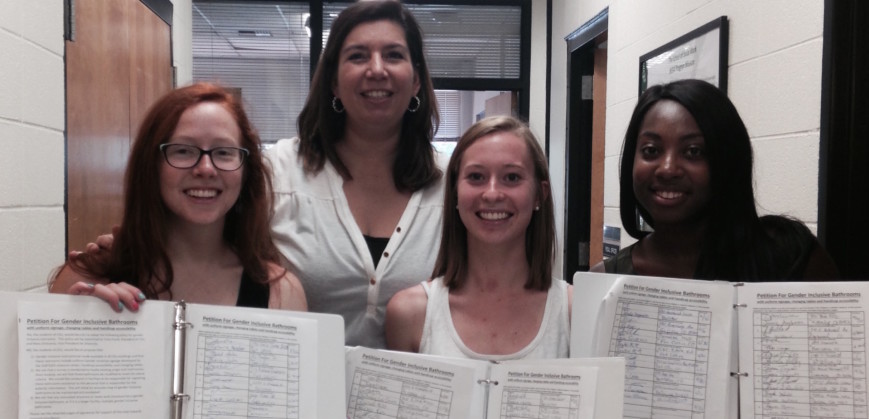
Social Work Policy class members (from left) Kelly Connor, Professor Marie Villescas Zamzow, Dani Nicodemus and Tierra Mcghee collected several hundred signatures on a petition to the CSU administration calling for single-stall restrooms on campus to be designated as intended for use by individuals of all gender identities. They have created an online survey to help develop a campus-wide policy on the issue.
As Colorado State launches into its five-year building program, a group of social work students, with the support of the Vice President for Diversity, wants to make sure everyone can find safe and accessible restrooms on campus.
“We actually had a committee working on the issue of inclusive signage with Facilities Management when a social work class put together a petition for a University-wide standard on how to designate single-stall toilets that can be used by any gender,” said Mary Ontiveros, VP for Diversity. “We decided to work together and gather input from the campus community.”
Kelly Connor and Dani Nicodemus were students in a Social Work class that studied policies related to social justice and equity issues. They had talked about the issues facing transgender and gender non-conforming people when it comes to using segregated toilets, and set out to determine the University’s policy on accessible restrooms.
The first step was to identify and locate all the single-stall gender-inclusive facilities on campus – and even that was a challenge.
“The map provided by the GLBTQ^2A Resource Center showed only 25 single stall restrooms across campus, but we learned through Facilities that there are close to 58 single-stall restrooms. However, they are not all labeled to signify gender inclusivity. ” Connor said. “At first we thought the map should just be updated, but then we thought, ‘How do we let people know a restroom is open to all?’”
No campus-wide policy
Further research revealed that there is no campus-wide policy on what sign to use to designate a gender-inclusive restroom. In fact, there is no consensus among universities or other public facilities nationwide on this issue.
At CSU, each building has adopted its own signage, which can be confusing, according to Shay Trettin, a transgender student. He said that for people with non-binary gender identities, one of the alternatives to finding a safe, accessible restroom is to avoid going to the bathroom at all while on campus.
“The University has been working on increasing the number of gender-inclusive restrooms, but they can be difficult to find,” he said. “Single-stall restrooms are far and few between on the main campus, especially in south campus buildings.”
Trettin got involved with the signage project when Connor and Nicodemus, her research partner, developed and circulated a petition calling on the University to adopt best-practice policies for gender-inclusive facilities, including requiring single-stall restrooms to be designated as intended for use by individuals of all gender identities and expressions.
“We collected more than 300 signatures in just a few hours with our Social Work Policy classmates,” Connor said. “We mailed the signatures to Mary O. and Tony Frank, and were later asked to become a part of the subcommittee focused on gender-inclusive policies.”
Survey next step
The next step toward a standard signage policy is a survey of campus. The subcommittee has put together an online survey with three graphic alternatives and three label alternatives.
The survey will be open until Nov. 6, and all members of the campus community are urged give input on which graphic and wording they prefer to designate a gender inclusive restroom. The survey can be found here.
This survey is simply gathering opinions to take back to the Inclusive Physical and Virtual Campus Committee, according to Ontiveros. The results will help to inform the committee as it determines the appropriate signage to recommend for campus-wide usage.
It may have started as a class project, but Connor says she is energized that she and her group have been able to have an effect on University policy – and that will perhaps set a standard for other universities in the process.
“I had no idea that we would be heard so quickly,” she said. “I hope we can make CSU a leader in establishing best practices for gender inclusivity, and it’s gratifying that we have such support from the administration.”